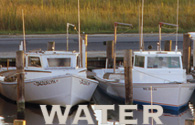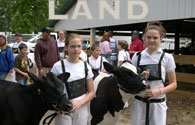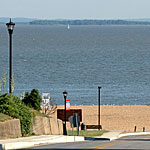 Betterton
Beach Betterton
Beach
With a gentle, sandy slope near the mouth of
the Sassafras River, where fresh-water currents lower
the salinity of the upper Chesapeake, Betterton Beach
is one of a few bay beaches that is nettle-free. Once
a deep water landing for steamboats, this recreational
park now offers swimming, boating, fishing, picnicking.
Stop and stretch your legs, cool off, and enjoy a picnic
lunch in this 19th century waterfront trading village.
 C&D Canal Museum C&D Canal Museum
The Chesapeake & Delaware Canal runs 14 miles long,
450 feet wide and 35 feet deep, connecting the Delaware
River with the Chesapeake Bay. Completed in 1829, the
canal was hand-dug by some 2,600 men digging and hauling
dirt from the ditch. Today, the canal is a modern, sea-level
commercial waterway that is the busiest canal in the
United States and the 3rd busiest in the world. The
waterwheel and pumping engines remain in the original
pumphouse, which is now the museum. These steam engines
are the oldest of their type in America that are still
on their original foundations. The museum is open
year round, Monday-Friday, 8am to 4pm, year round.
Saturday - Sunday, 11am - 4pm, April - October.
Admission is free.
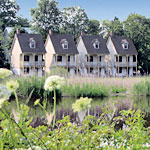 Captains’ Houses of Centreville Captains’ Houses of Centreville
The Captains’ Houses stand as sentinels to
their own history. Though privately owned, these architecturally
unique houses date
to the early 19th century. They were built by Captain
John Ozmon for the captains and crew members of his
Chesapeake Bay schooners.
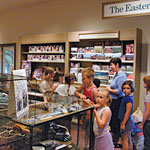 Chesapeake Exploration Center’s
“Our Chesapeake Exploration Center’s
“Our
Chesapeake Legacy”
This interactive exhibit at the Chesapeake
Exploration Center explores man’s close relationship
with the Bay and how that relationship has shaped our
culture and history, and conversely, how we have shaped
the environment of the Bay. The
hands-on exhibit highlights topics such as the formation
of the bay, the settlement of the region, the tobacco
era, the seafood industry, the opening of the bay bridge,
how we can save the bay, and much more. A great introduction
to start your Chesapeake Country visit!
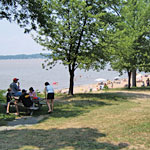 Crystal Beach Crystal Beach
With wonderful river vistas, this sandy
beach along the Elk River located at the
end of Route 282, is open to the public.
Picnic tables, a concession stand, and a fantastic view
of Turkey Point offers a respite by the bay. (Admission fee)
|
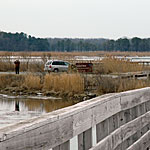 Eastern
Neck NWR Eastern
Neck NWR
Located at the mouth of the Chester River,
Eastern Neck National Wildlife Refuge is a major feeding
and resting place for migratory and wintering waterfowl.
It is a benchmark site for remnant populations of the
endangered Delmarva Fox Squirrel, now found in only
4 counties on Maryland's Eastern Shore. The threatened
southern bald eagle, our national symbol, also calls
this island refuge home. Nearly six miles of roads and
trails are open to visitors most of the year. Boardwalks
and observation
decks provide opportunities to observe a
variety of habitats
 Rock Hall Rock Hall
Officially established in 1707, Rock Hall is
an important port of call. Rock Hall offers visitors
numerous opportunities to experience the Chesapeake
Bay and the heritage of this working waterfront community.
Rock Hall Museum portrays a century of life in this
town known as “The Pearl of the Chesapeake”;
Tolchester Revisited Museum preserves the bygone era
of a once popular bayside park 1877 to 1962; and the
Waterman’s Museum presents the rich history of
the maritime trades, which helped build this wonderful
town. Visitor’s can charter a boat from the harbor,
launch a boat at Bayside Landing, or relax by the Bay
at Rock Hall Beach.
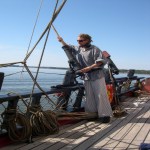 Schooner
Sultana Schooner
Sultana
Known as the “Schoolship of the Chesapeake”,
the Schooner Sultana is a 1768 replica ship whose motto
is “Preservation through Education.”
This sailing classroom hosts students throughout the
region, exploring the life of an 18th century sailor,
learning about history and the environment so that students
gain a greater understanding of the national treasure
that is the Chesapeake Bay. Public sails and numerous
ports of call are offered throughout the sailing season.
Downrigging weekend in November attracts numerous tall
ships to Chestertown.
 Turner’s Creek Turner’s Creek
The marriage of history and recreation
make this 147-acre park a unique destination. The natural
harbor of Turner’s Creek was once the site of
a thriving local shipping port, disbursing agricultural
goods throughout the Bay region. Now the tranquil harbor
is home to several crabbing and fishing boats, a fishing
pier, pavilion, and other recreational amenities.. The
last remaining pre- Civil War granary along the rivers
of the Chesapeake still stands on the site where an
earlier commissary shipped supplies to Washington’s
troops at Valley Forge. The park is also home to a colonial
mansion known as Knock’s Folly .
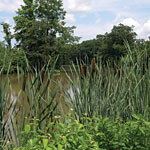 Urieville Lake Urieville Lake
Urieville Lake was a mill pond constructed
prior to the Revolutionary War. The mil
(c. 1720), constructed by Colonel Isaac
Perkins, was charged milling flour for Washington’s
Army. The lake, operated as a Freshwater Fishery by
the Department of Natural Resources, offers fishing
and picnicking. A great place to cast a line along the
byway.
|

